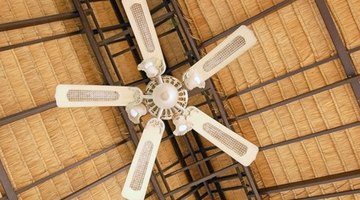Ceiling Fans & Allergies
Table of Contents
Ceiling fans are a simple luxury that can help you feel more comfortable in your home. Unfortunately, this luxury can come at a high cost if you suffer from dust mite allergies. According to the American Academy of Allergy, Asthma and Immunology (AAAAI), dust mites are the most common allergy triggers.

Ceiling fans can be a breeding ground for dust mites, especially if cleaning is neglected.
Benefits
Using ceiling fans is common, especially in areas that stay warm throughout the year. Ceiling fans are used in conjunction with air conditioning to help a particular room stay cool. Fans are sometimes used alone to save electricity or in homes that do not have central air conditioning. Perhaps one of the most common uses of a ceiling fan is in your bedroom at night to help you sleep better.
Effects on Allergies
Unfortunately, ceiling fans are a common host to dust and dust mites. Dust mites drop feces within dust, which aggravates allergy symptoms. Dust and subsequent dust mites accumulate on ceiling fan blades whether the unit is in use or not. When a dirty ceiling fan runs, dust and dust mites can spread throughout the room, especially onto surfaces such as carpets and bedding. These effects can be detrimental, especially if you are allergic to dust mites.
Considerations
Dust mite allergy sufferers are better off avoiding using ceiling fans. Keep Kids Healthy advises against using ceiling fans to prevent the accumulation of dust mites in your room and the subsequent allergy symptoms. Instead, consider using an air conditioning unit to help keep you cool and comfortable. Consider using a dehumidifier in your room to help prevent dust mites from thriving.
Cleaning
If you cannot live without a ceiling fan, proper cleaning must be done to help prevent dust mite allergy symptoms. The Housekeeping Channel recommends that you use a damp cloth to trap dust while removing it. If you use a feather duster on the fan blades, you will simply spread dust mites rather than trapping them. You can also use a vacuum, but be aware that some of the dust might fly into the air during the process. Always wear a mask to avoid inhaling dust or dust mites when cleaning your ceiling fan.
Other Measures
Other areas within your home might be susceptible to dust mite accumulation. Having a ceiling fan in a room will make matters worse. No matter whether you have a ceiling fan, you can use other preventive measures to combat dust mite allergies. The AAAAI recommends that you place pillows and mattresses in airtight covers and that you wash your bedding in hot water on a regular basis. Consider removing carpeting or vacuuming it at least once a week.
References
Writer Bio
Kristeen Cherney began writing healthy lifestyle and education articles in 2008. Since then, her work has appeared in various online publications, including Healthline.com, Ideallhealth.com and FindCollegeInfo.com. Cherney holds a Bachelor of Arts in communication from Florida Gulf Coast University and is currently pursuing a Master of Arts in English.
Photo Credits
- ceiling fan image by Adrian Hillman from Fotolia.com
- ceiling fan image by Adrian Hillman from Fotolia.com
More Articles



